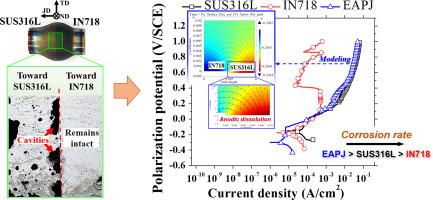当前位置:
X-MOL 学术
›
Mater. Charact.
›
论文详情
Our official English website, www.x-mol.net, welcomes your
feedback! (Note: you will need to create a separate account there.)
Experimental and numerical studies on the electrochemical properties of an electrically assisted pressure joint of austenitic stainless steel and Ni-based superalloy
Materials Characterization ( IF 4.8 ) Pub Date : 2020-07-01 , DOI: 10.1016/j.matchar.2020.110404 Sam Yaw Anaman , Solomon Ansah , Yong-Fang Li , Hoon-Hwe Cho , Jong-Sook Lee , Heung Nam Han , Sung-Tae Hong
Materials Characterization ( IF 4.8 ) Pub Date : 2020-07-01 , DOI: 10.1016/j.matchar.2020.110404 Sam Yaw Anaman , Solomon Ansah , Yong-Fang Li , Hoon-Hwe Cho , Jong-Sook Lee , Heung Nam Han , Sung-Tae Hong

|
Abstract Electrochemical properties of an austenitic stainless steel and Ni-based superalloy dissimilar joint, produced by electrically assisted pressure joining (EAPJ), are investigated and compared to the base metals in a 3.5% NaCl solution at room temperature. The microstructural analysis reveals a sound joint without the presence of secondary phases and/or low melting phases (Laves) in the EAPJ joint due to the short diffusion time and rapid local heating. However, the microstructure of the joint is characterized by some degree of grain refinement, high dislocation densities, and a decrease in major passive-forming elements across the joint interface. These microstructural changes cause an increase in the risk of galvanic corrosion across the joint, with the SUS316L side undergoing severe localized corrosion attacks. Furthermore, a numerical model is established using the corrosion parameters from the experiment to simulate the electrochemical behavior of the joint in a neutral environment. The simulation results agree reasonably well with the experimental results in relation to the corrosion potentials, current densities, and the corresponding corrosion rates. Also, the model is capable of tracking the dissolution of the SUS316L side of the joint during the corrosion process for any period.
中文翻译:

奥氏体不锈钢与镍基高温合金电辅助压力接头电化学性能的实验和数值研究
摘要 研究了通过电辅助压力连接 (EAPJ) 生产的奥氏体不锈钢和镍基高温合金异种接头的电化学性能,并在室温下与 3.5% NaCl 溶液中的母材进行了比较。微观结构分析表明,由于扩散时间短和局部加热迅速,EAPJ 接头中不存在二次相和/或低熔点相 (Laves) 的良好接头。然而,接头微观结构的特点是一定程度的晶粒细化、高位错密度以及接头界面上主要被动形成元素的减少。这些微观结构的变化会增加整个接头的电偶腐蚀风险,SUS316L 侧会受到严重的局部腐蚀攻击。此外,使用实验中的腐蚀参数建立数值模型来模拟接头在中性环境中的电化学行为。在腐蚀电位、电流密度和相应的腐蚀速率方面,模拟结果与实验结果相当吻合。此外,该模型能够跟踪任何时期腐蚀过程中接头 SUS316L 侧的溶解情况。
更新日期:2020-07-01
中文翻译:

奥氏体不锈钢与镍基高温合金电辅助压力接头电化学性能的实验和数值研究
摘要 研究了通过电辅助压力连接 (EAPJ) 生产的奥氏体不锈钢和镍基高温合金异种接头的电化学性能,并在室温下与 3.5% NaCl 溶液中的母材进行了比较。微观结构分析表明,由于扩散时间短和局部加热迅速,EAPJ 接头中不存在二次相和/或低熔点相 (Laves) 的良好接头。然而,接头微观结构的特点是一定程度的晶粒细化、高位错密度以及接头界面上主要被动形成元素的减少。这些微观结构的变化会增加整个接头的电偶腐蚀风险,SUS316L 侧会受到严重的局部腐蚀攻击。此外,使用实验中的腐蚀参数建立数值模型来模拟接头在中性环境中的电化学行为。在腐蚀电位、电流密度和相应的腐蚀速率方面,模拟结果与实验结果相当吻合。此外,该模型能够跟踪任何时期腐蚀过程中接头 SUS316L 侧的溶解情况。











































 京公网安备 11010802027423号
京公网安备 11010802027423号